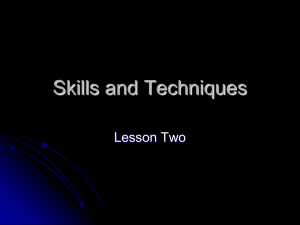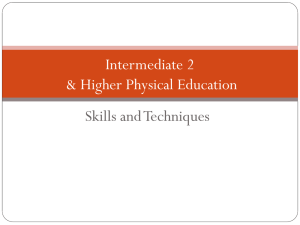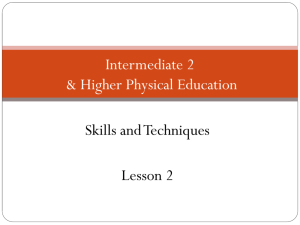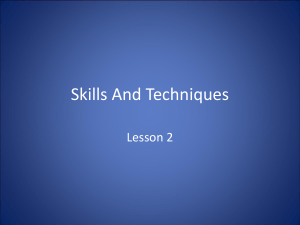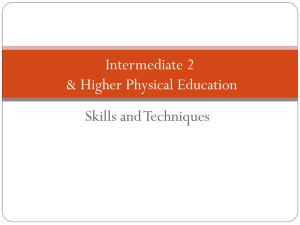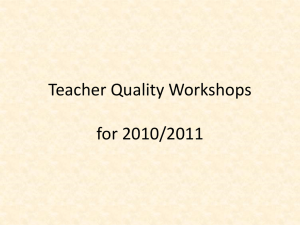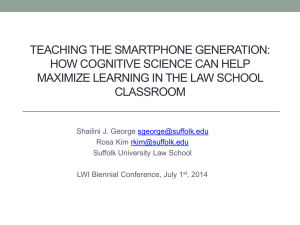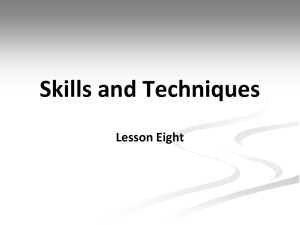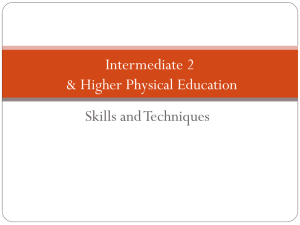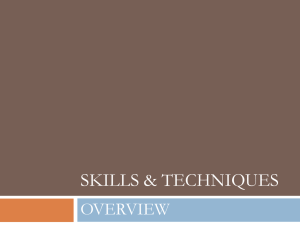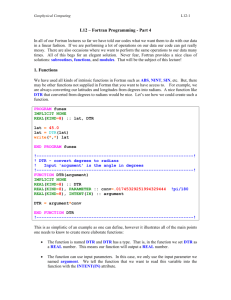Skills and Techniques
advertisement
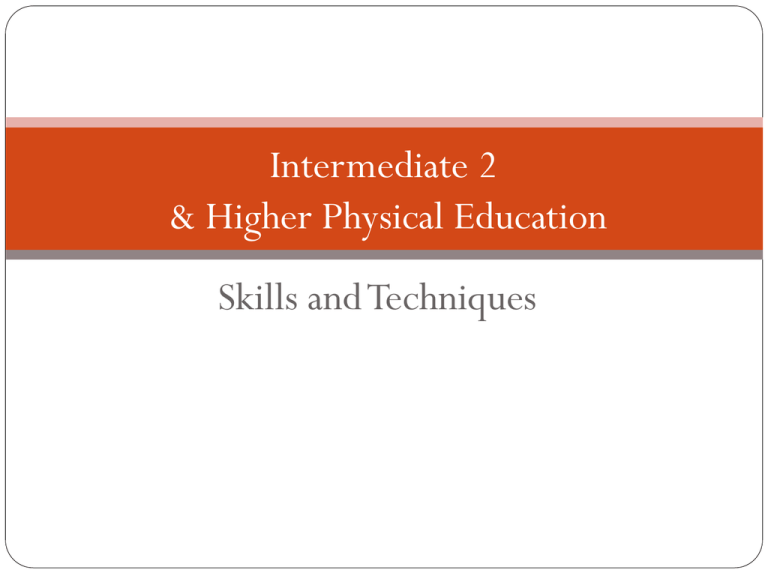
Intermediate 2 & Higher Physical Education Skills and Techniques Lesson objectives… Recap - Principles of Effective Practice Recap - Feedback and Motivation Graffiti Poster for Feedback – Motivation – Principles of effective practice Stages of Skill Learning What stage of skill learning are we at and what have we been doing Types/Methods of Practice Issue homework for Friday 9th December – 2 tasks Recap of last Wednesday Click here for last Wednesdays lesson Cooperative Learning Task Instructions Get into a group of six. Sit at a graffiti poster. Feedback Motivation Principles of effective practice At your poster write down any word or phrase that you can think of which relates to the subject area. When instructed move to the next graffiti poster. At your new poster write down any word or phrase that you can think of which relates to the subject area. Repeat the above. Stages of Skill Learning What are the three stages of skill learning? STAGES OF LEARNING Cognitive Associative Autonomous Stages of skill learning as a journey Associative Autonomous Cognitive Cognitive Stage During the planning stage, you find out what the skill involves – work out the subroutines: Preparation Action Recovery At the cognitive stage of skill learning. Limited ability and knowledge of skill. Observing Model performer helps improve knowledge of what it means to perform effectively. Even although some of the subroutines involved in the skill maybe new, it does not mean that you are at the beginner level in badminton. Beginner Level Badminton Player After establishing the different subroutines you make your first attempts at learning the skill Errors are likely to be common during the planning stage. As a result of this you will need lots of advice and encouragement What was the first thing you did during the cognitive stage? Why did you break the OHC down? What did you do after establishing the subroutines? Why was it important to receive feedback at this stage? What was the first thing you did during the cognitive stage? During the cognitive stage, I found out exactly what the overhead clear involved. To do this I observed a model performing playing the stroke. I was then able to break the skill down into three phases: Preparation Action Recovery Why did you break the OHC down? This enabled me to identify each of the subroutines that make up the skill. By doing this I had a clear understanding of the movements I had to perform in order to play an effective overhead clear. Even although some of the subroutines involved in the overhead clear were new, I wasn’t a badminton beginner, I had some previous experience of the activity. What did you do after establishing the subroutines? After establishing the subroutines involved I made my first attempts at performing the skill by shadowing the movements of a model performer, to do this I used shadow practice. As my performance improved I attempted different shadow practices which got progressively more difficult. It was important to ensure my practice was progressive to keep the practices challenging and prevent boredom. Why was it important to receive feedback at this stage? During these early stages I made a lot of errors, for this reason it was important that I received regular positive feedback. By receiving regular verbal feedback from my partner I could very quickly correct errors in my performance. Due to the number of errors I initially made it was important the feedback was positive to keep my motivation levels up. Types / Methods of Practice Gradual Build Up Conditioned Stage 5 Games Pressure StageDrills 4 Gradual Build Combination Up Stage 3 Practice Repetition Stage 2 Practice Shadow Stage Practice 1 Methods of practice used on our journey Shadow Practice Cognitive Repetition Practice Associative Combination Practice Pressure Drills Conditioned Games Autonomous Homework Due – Friday 9th December Task 1: Describe what you did at the cognitive stage of skill learning to develop your overhead clear. Give specific performance related examples to support your answer. Task 2: Describe a complex skill which you found to be a weakness. Explain why you considered it to be a weakness. Answer for task 2 should include • Intro – aim/objective of overhead clear • Explanation as to why OHC is a complex skill • Description of overhead clear • Comparison of your performance to that of a model performer at the Preparation / Action / Recovery stages. • Summary of how this affected the effectiveness of your overhead clear. The overhead clear video used in class may help you with this answer http://www.youtube.com/watch?v=qhe_rRJR9_Y
